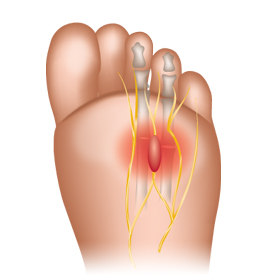 Morton’s neuroma is a foot condition that can be quite painful. The ball of the foot is affected by this condition, typically in the area between the third and fourth toes. It is often described as feeling like there is a stone in your shoe.
Morton’s neuroma is a foot condition that can be quite painful. The ball of the foot is affected by this condition, typically in the area between the third and fourth toes. It is often described as feeling like there is a stone in your shoe.
Morton’s neuroma affects the nerves that lead to the toes. The tissue around the nerves thickens, which causes a sharp, burning pain in the foot. It can also cause a sensation of stinging and numbness.
Although the exact cause of Morton’s neuroma is unknown, wearing high heels has been connected to the development of this condition. People who experience this condition often find relief by giving up high heels and wearing lower, roomier shoes, instead.
Symptoms of Morton’s Neuroma
Unlike some foot conditions, such as bunions, Morton’s neuroma does not have any visible indicators of a problem. You may not be able to see a problem, but you will feel it. It may feel like your sock is folded over or like you have a rock in your shoe.
The pain is usually worse when you are bearing weight on your feet. Patients also report feeling a burning sensation in the ball of the foot, which can extend to the toes, as well as numbness and tingling.
If you have this type of pain, you should rest the feet and start wearing roomier, more supportive footwear. If you do not experience relief within a few days, you should consult a doctor.
Causes and Risk Factors of Morton’s Neuroma
The cause of Morton’s neuroma is unclear. However, it seems that it develops in response to injury, pressure, or irritation of the nerves in the feet.
There are several risk factors that contribute to the development of Morton’s neuroma. They include the following:
- High heels – Wearing high heeled shoes increases the risk of developing Morton’s neuroma. Any tight fitting shoes can put too much pressure on the ball of the foot and the toes, which irritates the nerves and can lead to the development of a neuroma.
- High impact sports – Certain sports, like running, increase the risk of developing Morton’s neuroma. High impact sports or sports that involve repetitive striking of the feet can put excessive strain on the feet and cause trauma. Sports that require a person to wear tight shoes, like rock climbing or skiing, can also lead to the development of Morton’s neuroma.
- Deformities of the feet – People who have foot conditions like high arches, flat feet, or bunions are more likely to develop Morton’s neuroma.
Although the explanation is unclear, research has shown that women are much more likely to develop Morton’s neuroma than men.
Treatment for Morton’s Neuroma
The first thing that you should do if you have Morton’s neuroma is to start wearing proper footwear. Your shoes should be supportive, but also provide plenty of room in the toe box so that there is no pressure being placed on the toes. Shoes that have lower heels will also help to reduce the pressure being placed on the ball of foot area.
Shoes that have laces are also a good choice, because they allow you to loosen the laces to adjust for width. You might also consider trying shoes in an extended width rather than a standard width. Look for shoes that have thick soles and will absorb shock well.
You can also benefit from using shoe inserts or custom orthotics, with a pad placed to give additional support at the metatarsal area. These devices will help to protect and support your feet while minimizing any irritation of your neuroma.
It is a good idea to take a break from your regular activities when you experience pain. Give the feet time to rest, and apply ice to reduce pain and swelling. Your doctor / pharmacist may recommend taking anti-inflammatory medications also.
If you have Morton’s neuroma, you should visit Foot Solutions UK. We offer a wide variety of comfortable footwear, arch supports, and custom orthotic inserts (custom inserts) that will help to relieve your pain. Stop by Foot Solutions UK today to learn more.
































